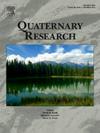追踪南非开普省南海岸已灭绝的巨型开普斑马
IF 1.8
3区 地球科学
Q3 GEOGRAPHY, PHYSICAL
引用次数: 3
摘要
摘要大角斑马(Equus capensis)是非洲南部已灭绝的第四纪大型哺乳动物之一,也是非洲第四纪最大的马。在南非开普省南海岸的风成岩中发现了26个更新世等径点。通过光激发光确定了161±12ka至43±4ka的年龄范围。超过一半的遗址包含大型等径岩,代表了第一批归属于E.capensis的异径岩。quagga(E.quagga-quagga)可能已经登记了较小的equid轨道。开普省南海岸的E.capensis踪迹丰富,与该地区该物种的身体化石稀少形成对比,与从身体化石记录中获得的印象形成对比,即E.capensis主要是该地区西海岸物种。新的数据说明了身体化石和痕迹化石记录相互补充的能力。Palaeo Agulhas平原提供的合适栖息地的丧失可能是导致这种大型食草动物灭绝的一个因素。Driefontein的一条长长的马道被认为是E.capensis的,这增加了全球马道化石的稀少记录。本文章由计算机程序翻译,如有差异,请以英文原文为准。
Tracking the extinct giant Cape zebra (Equus capensis) on the Cape south coast of South Africa
Abstract The giant Cape zebra (Equus capensis) is one of the extinct Quaternary large mammal species of southern Africa, and the largest equid from the Quaternary of Africa. Twenty-six Pleistocene equid tracksites have been identified in aeolianites on the Cape south coast of South Africa. An age range of 161 ± 12 ka to 43 ± 4 ka has been established through Optically Stimulated Luminescence. More than half of the sites contain large-equid tracks, representing the first ichnosites attributed to E. capensis. Smaller equid tracks may have been registered by the quagga (E. quagga quagga). The abundance of E. capensis tracksites on the Cape south coast contrasts with the paucity of body fossils of the species from the region, contrasting with the impression obtained from the body fossil record that E. capensis was predominantly a west coast species in the region. The new data illustrate the capacity of the body fossil and trace fossil records to complement each other. The loss of suitable habitat provided by the Palaeo-Agulhas Plain was probably a contributing factor in the extinction of this large-bodied grazer. A long trackway at Driefontein, attributed to E. capensis, adds to a sparse global record of fossil horse trackways.
求助全文
通过发布文献求助,成功后即可免费获取论文全文。
去求助
来源期刊

Quaternary Research
地学-地球科学综合
CiteScore
4.70
自引率
8.70%
发文量
57
审稿时长
3 months
期刊介绍:
Quaternary Research is an international journal devoted to the advancement of the interdisciplinary understanding of the Quaternary Period. We aim to publish articles of broad interest with relevance to more than one discipline, and that constitute a significant new contribution to Quaternary science. The journal’s scope is global, building on its nearly 50-year history in advancing the understanding of earth and human history through interdisciplinary study of the last 2.6 million years.
 求助内容:
求助内容: 应助结果提醒方式:
应助结果提醒方式:


